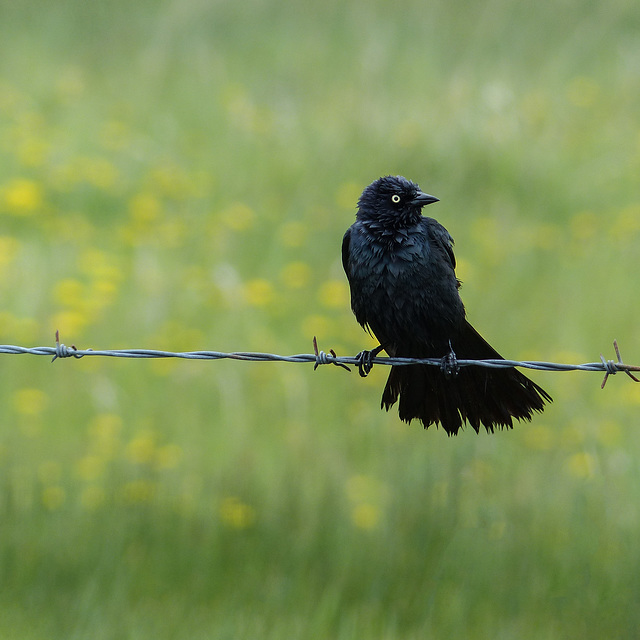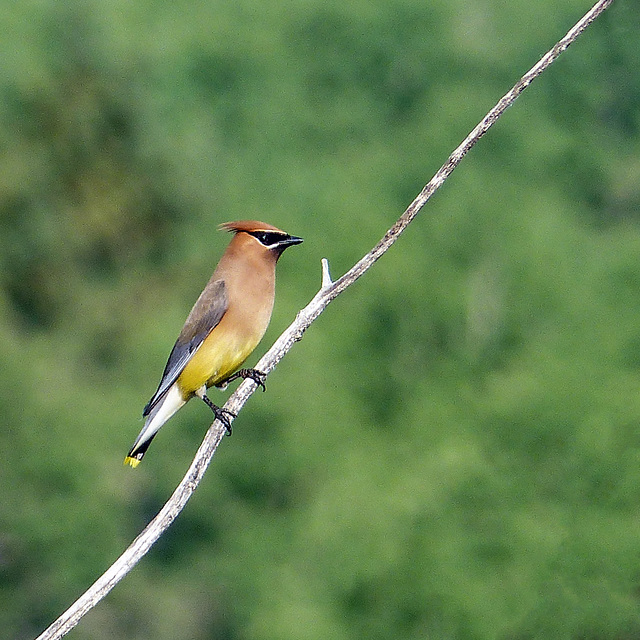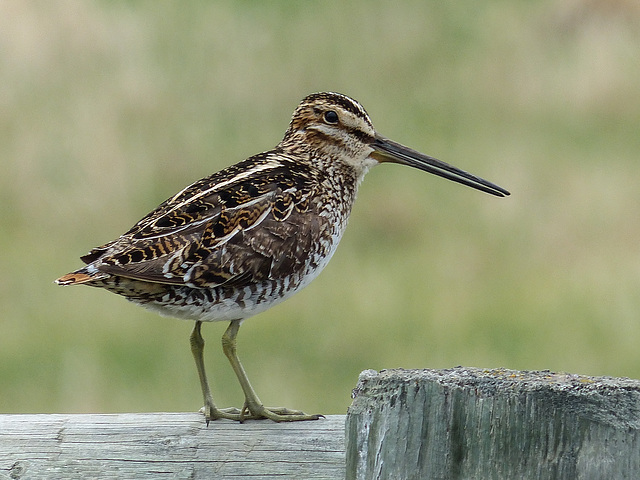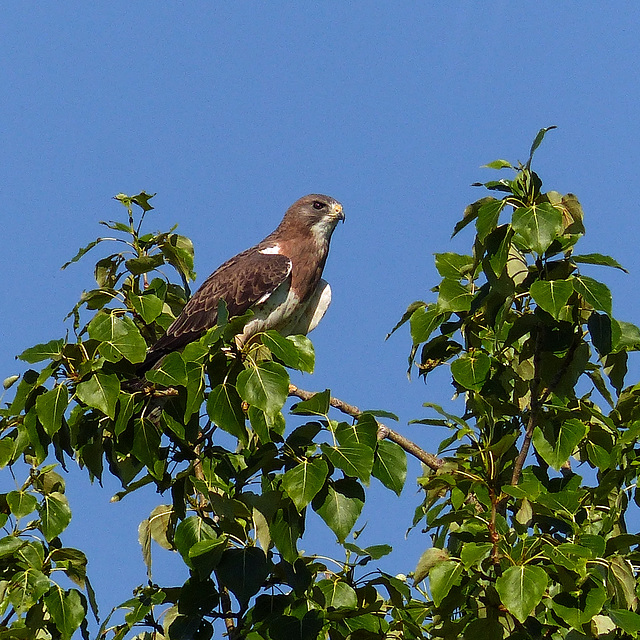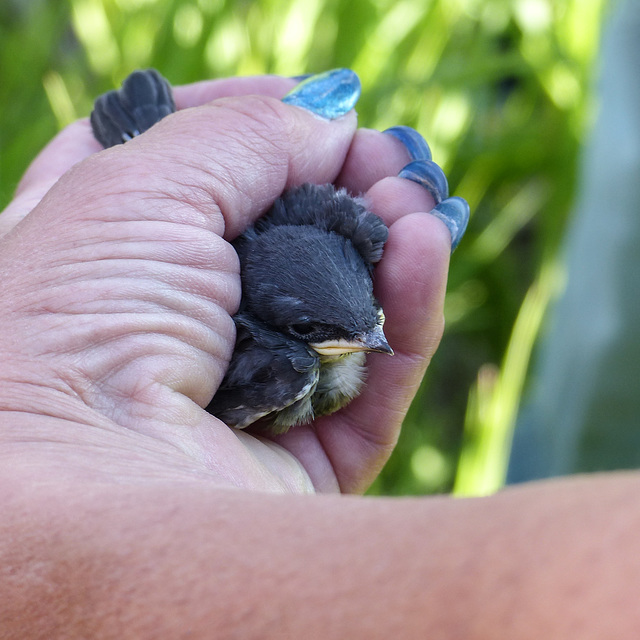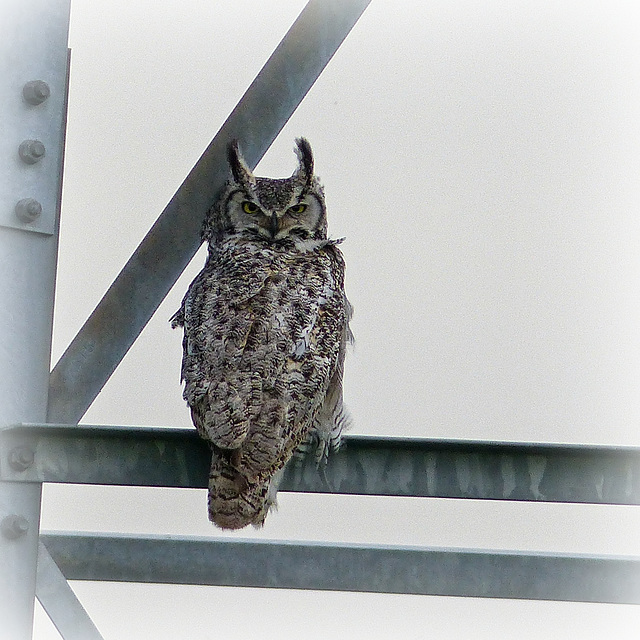
Birds of Alberta 9
27 Jun 2014
Brewer's Blackbird with food for his babies
Photographed this male Brewer's Blackbird a few days ago, on 27 June 2014, when I drove a few of the backroads SW of the city. This is such a busy time for birds, collecting insects to feed to their young.
"A bird to be seen in the full sun, the male Brewer’s Blackbird is a glossy, almost liquid combination of black, midnight blue, and metallic green. Females are a staid brown, without the male’s bright eye or the female Red-winged Blackbird’s streaks. Common in towns and open habitats of much of the West, you’ll see these long-legged, ground-foraging birds on sidewalks and city parks as well as chuckling in flocks atop shrubs, trees, and reeds."
www.allaboutbirds.org/guide/brewers_blackbird/id
The famous, annual Calgary Stampede begins tomorrow, with the Stampede Parade taking place in the morning. William Shatner (from Star Trek) is our Parade Marshall. No worries about the weather, as it's a beautiful, sunny day today and tomorrow is supposed to be good, too.
23 Jun 2014
1 favorite
Throat-tickling supper
HAPPY 4th JULY to all Americans, whether at home or overseas!
Somehow, I just can't imagine having a hairy caterpillar dropped down my throat, lol! No doubt this female Mountain Bluebird's babies don't mind, though. Photographed when I went for a drive along the backroads SW of the city, on 23 June 2014.
In Bluebirds, the blue colour is produced by the structure of the feather - there is no blue pigment. "Tiny air pockets in the barbs of feathers can scatter incoming light, resulting in a specific, non-iridescent color. Blue colors in feathers are almost always produced in this manner. Examples include the blue feathers of Bluebirds, Indigo Buntings, Blue Jay's and Steller's Jays."
www.allaboutbirds.org/guide/Mountain_Bluebird/id
www.jstor.org/discover/pgs/index?id=10.2307/4077277&i...
The famous, annual Calgary Stampede begins today, with the Stampede Parade taking place downtown this morning. William Shatner (from Star Trek) is our Parade Marshall. No worries about the weather, as it's a beautiful, sunny day today. Temperature is 21°C so far, so not unbearably hot for people who are lining the parade route or taking part in the parade. Yesterday afternoon, we got up to around 32°C, which was too hot for my liking.
12 Jun 2014
1 favorite
Dandelion bokeh
I'm posting this image as much for the Dandelion bokeh as for the Brewer's Blackbird. Taken on 12 June 2014, when I went for a drive along the backroads SW of the city.
"A bird to be seen in the full sun, the male Brewer’s Blackbird is a glossy, almost liquid combination of black, midnight blue, and metallic green. Females are a staid brown, without the male’s bright eye or the female Red-winged Blackbird’s streaks. Common in towns and open habitats of much of the West, you’ll see these long-legged, ground-foraging birds on sidewalks and city parks as well as chuckling in flocks atop shrubs, trees, and reeds." From AllAboutBirds.
www.allaboutbirds.org/guide/brewers_blackbird/id
05 Jul 2014
3 favorites
Cedar Waxwing
This was one quick shot taken yesterday afternoon (5 July 2014), on my way home from a long day of driving. Photographed at a pond, SW of the city. In the summer months, we have these Cedar Waxwings; in the winter, we get the Bohemian Waxwings. Thanks, Donna (Ducks & Daisies), for adding this website, which I had never seen before, to your comment!
10000birds.com/cedar-waxwing-vs-bohemian-waxwing.htm
At the last minute, I decided I would have to get out of the house yesterday. I just couldn't take being in an "oven" any more. Not complaining about the hot, sunny weather we are having at the moment, but my house turns into an oven and then tends to stay that way for many days or weeks afterwards. I had planned on leaving the house earlier than I did (10;00 a.m.) and drove NW of the city and NW of Cochrane. Hadn't been that way for a long time and wanted to see if I could find an owl of some sort, especially a Great Gray Owl. No luck, and in fact it seemed like all wildlife was in hiding, except for four Deer.
My morning's finds included a patch of beautiful Indian Paintbrush flowers (deep pink, yellow, green and peach colours) Also a noisy little Wren that I saw when I pulled over to take a look down a hillside to see if I could see the Red Fox that had just run across the road ahead of me - no luck. The next sightings were a lone Deer - forgot to check its tail, but judging by the enormous size of its ears, it had to have been a Mule Deer - and a Tree Swallow that was perched on its bright orange nesting "box". I wonder who chose the colour of the box this year; he or his mate, lol. Nearby, there were several Swallowtail butterflies down in the mud along the edge of the road. Before I could get there, a car came along in the opposite direction and of flew every single one. By the time I had photographed a few wildflowers, one butterfly did return, so I was able to get a few shots.
Deciding to return to Highway 1a the same way as I came, I passed a couple of horses that always seem to be in the same place. I'm never sure about the health of these two, and they never seem "happy" animals, though maybe they are just getting very old. When I reached the road I wanted to check out (including for a possible owl), I found that it had just been oiled ready for a new surface to be laid, so that plan went out the window.
Wanting to stay away from my unpleasantly hot house for as long as possible, I came home via Bragg Creek and some of the backroads that I love, SW of the city. Brown-Lowery Provincial Park was my first stop - and it has the wonderful, added benefit of washrooms in the parking lot - the first ones I'd seen all day! I checked out the area near the parking lot and then went maybe a hundred feet into the forest. After checking for any fungi (none), I heard a very loud cracking of branches and eventually spotted a huge, very dark shape through the trees. From that angle, it looked horribly like a Bear, but when it lifted its head from feeding, I was so relieved to see that it was "only" a Moose! A young couple were coming along the trail towards me and I said they must have seen it even closer. My voice was heard by the animal and unfortunately it moved quickly away. I like to think that a Bear or Cougar would react in the same way, lol!
From Brown-Lowery, I passed my favourite little wetland and found the Snipe standing, as usual, on a fence post. Sorry, everyone, you might just get fed up of Snipe photos - if you aren't already!
Got home around 6;00 p.m., feeling content that, even though the morning had been pretty disappointing, the day was a a good one. Would love to get in my car and go out again today, but I have things to get done and I don't want to overdo the driving, in case I make my shoulders any worse.
25 May 2013
3 favorites
A Snipe from last year
I didn't realize until I had finished editing it, that this shot was taken last summer. This year, I've taken lots of photos of Wilson's Snipes, so I really didn't need to use an older photo. This Snipe was seen at a different location, but still along one of the backroads SW of the city. I always forget how small these birds are - you often don't see them till you are almost right up to them.
"These plump, long-billed birds are among the most widespread shorebirds in North America. They can be tough to see thanks to their cryptic brown and buff coloration and secretive nature. But in summer they often stand on fence posts or take to the sky with a fast, zigzagging flight and an unusual “winnowing” sound made with the tail." From AllAboutBirds.
www.allaboutbirds.org/guide/wilsons_snipe/id
"Wilson's Snipe (Gallinago delicata) is a small, stocky shorebird. This species was considered to be a subspecies of the Common Snipe (G. gallinago) until 2003 when it was given its own species status. Wilson's Snipe differs from the latter species in having a narrower white trailing edge to the wings, and eight pairs of tail feathers instead of the typical seven of the Common Snipe. Its common name commemorates the American ornithologist Alexander Wilson." From Wikipedia.
en.wikipedia.org/wiki/Wilson's_snipe
According to Fisher and Acorn's book, "Birds of Alberta", "the common Snipe is both secretive and well camouflaged, so few people notice it until it flushes suddenly from a nearby grassy tussock. As soon as the Snipe takes to the air, it performs a series of quick zigzags - an evasive maneuver designed to confuse predators. Because of this habit, Snipes were among the most difficult birds to shoot (in the days when shorebirds were hunted for sport), and skilled sportsmen were known as "snipers" - a term later adopted by the military."
youtu.be/Z16CUdX2g5Q
07 Jul 2014
1 favorite
Swainson's Hawk
I was out all evening on Monday, 7 July 2014, on Don Stiles' annual Bluebird Route trip. Don has been a Bluebird Monitor for about 30 years, so has great experience with Bluebirds - also with Tree Swallows and an occasional Wren that also use the wooden nest boxes! His route is along some of the backroads SW of the city. This time, we didn't see any baby Bluebirds, as all the young ones had already fledged and none of the pairs had a second clutch. We did see nest boxes with tiny Tree Swallow eggs in the nest, and also several nest boxes that had baby Tree Swallows in, around 12 days old. One box had 12 babies in - obviously belonging to two adult females! Can't imagine how they will all cope inside the box when they get bigger. Nice to see a very distant Baltimore Oriole - my first for this year - and various other birds, too. Near the beginning of the trip, this Swainson's Hawk flew and landed at the top of a tree, way down the road from us, but still within camera reach. Another great evening, Don - thanks so much for taking a few of us out with you!
"Swainson’s Hawks soar on narrow wings or perch on fence posts and irrigation spouts. These elegant gray, white, and brown hawks hunt rodents in flight, wings held in a shallow V, or even run after insects on the ground. In fall, they take off for Argentine wintering grounds—one of the longest migrations of any American raptor—forming flocks of hundreds or thousands as they travel." From AllAboutBirds.
www.allaboutbirds.org/guide/swainsons_hawk/id
en.wikipedia.org/wiki/Swainson's_hawk
According to the weather forecast, it looks like we are in for more very hot weather - love the sunshine, but can't cope with the high temperatures.
07 Jul 2014
1 favorite
A baby Tree Swallow about to be banded
Not my hand, by the way! Took this photo on 7 July 2014, whilst on one of Don Stiles' annual Bluebird outings to see the Mountain Bluebird nesting boxes along his route, SW of the city. Some of these wooden boxes have been taken over by Tree Swallows, which are also banded and counted. Unfortunately, this year, all the Bluebirds had already fledged, but we saw a few boxes that contained Tree Swallow eggs and some that contained several (around 6) Tree Swallow babies. Actually, one box had 12 baby Tree Swallows (12 days old?), all tightly snuggled together, so obviously two adult females were using the same box. I've never seen that before. Can't imagine how cramped it will be as the babies grow bigger and four adults need to get through the small hole of the box to feed them!
Most of the birds we saw had already been banded, but we did see Don band a few others that were now old enough to be banded. He places some dried grasses at the bottom of a bucket and places each baby in there after he has fitted a teeny band around one of its legs (actually, it's foot, as that first big bend is the heel.) Then they are all carefully placed back into the nesting box, ready for Mom and Dad to return to them, which they do immediately.
For anyone who might wonder if a baby bird is handled, will its parents pick up my scent and abandon it? The answer below is from the Cornell Lab of Ornithology:
A. It's a myth that parent birds will abandon young that have been touched by humans—most birds have a poor sense of smell, and birds in general identify their young using the same cues we humans do—appearance and sound. It's perfectly safe to pick up a fallen nestling and put it back in the nest, or to carry a fledgling out of danger and place it in a tree or shrub." Same would apply to bird banding.
NO BIRD OR WILD ANIMAL SHOULD EVER BE KEPT AS A PET!
10 Jul 2014
1 favorite
Dad on the pylon
Posting so late today (around 12:30 p.m.), after sleeping in, much later than usual. Unless I have to, I'm trying not to set my alarm, in order to get more sleep than I normally get, hoping to give my shoulder rotator cuffs and my back the best chance to improve.
Yesterday afternoon, I checked the weather forecast before dashing down to the Frank Lake area, SE of the city. Pretty much a spur of the moment thing. The temperature had gone down a few degrees from the unbearably hot day before, and the sun was shining. On the Weather Network, I discovered that there was a weather Alert in effect, possibly huge hailstones and also the possibility of a tornado. Thinking I might get a chance to see some interesting clouds, I decided that I would still go.
My first destination was Frank Lake, where I bumped into friend, Greg Wagner, who is extremely knowledgeable about the area and its wildlife, and does an amazing job of recording all his sightings. I saw Eared Grebes with their young ones (quite big now), a few Ibis and Black-crowned Night Herons (no photos). Did manage to get a few shots of a Sora (thanks for telling me to watch out for them, Greg!). After I'd finished at the blind, Greg took me to various spots around the lake, pointing out places where he had seen interesting things, hoping that they might still be there for me to see. Thanks so much, Greg, I enjoyed this and really appreciated it! One of these was a Western Kingbird - our more common Kingbird is the Eastern, so I was very happy to see a Western. We also passed by this male Great Horned Owl, who was perched on one of the huge pylons. He and his family seem to be doing well. I used Picmonkey to "frost" the edges of the photo, to soften the harsh metal of the pylon. Photo was quickly taken from inside the car, using 48x zoom and then cropped. Of course, more natural surroundings would have been nicer, but this family of owls likes to use this pylon : )
The clouds were building up as the hours went by and it did rain just a little when I was driving home. Fortunately, no hail or tornado!
07 Jul 2014
1 favorite
12 baby Tree Swallows!
Took this photo on 7 July 2014, whilst on one of Don Stiles' annual Bluebird outings to see the Mountain Bluebird nesting boxes along his route, SW of the city. Some of these wooden boxes have been taken over by Tree Swallows, which are also banded and counted. Unfortunately, this year, all the Bluebirds had already fledged, but we saw a few boxes that contained Tree Swallow eggs and some that contained several (around 6) Tree Swallow babies. Actually, the box seen in my photo had 12 baby Tree Swallows, all tightly snuggled together, so obviously two adult females were using the same box. I've never seen that before. Can't imagine how cramped it will be as the babies grow bigger and the adults need to get through the small hole of the box to feed them!
Most of the birds we saw had already been banded, but we did see Don band a few others that were now old enough to be banded. He places some dried grasses at the bottom of a bucket and places each baby in there after he has fitted a teeny band around one of its legs (actually, it's foot, as that first big bend is the heel.) Then they are all carefully placed back into the nesting box, ready for Mom and Dad to return to them, which they do immediately.
For anyone who might wonder if a baby bird is handled, will its parents pick up my scent and abandon it? The answer below is from the Cornell Lab of Ornithology:
A. It's a myth that parent birds will abandon young that have been touched by humans—most birds have a poor sense of smell, and birds in general identify their young using the same cues we humans do—appearance and sound. It's perfectly safe to pick up a fallen nestling and put it back in the nest, or to carry a fledgling out of danger and place it in a tree or shrub." Same would apply to bird banding.
NO BIRD OR WILD ANIMAL SHOULD EVER BE KEPT AS A PET!
Jump to top
RSS feed- Latest items - Subscribe to the latest items added to this album
- ipernity © 2007-2024
- Help & Contact
|
Club news
|
About ipernity
|
History |
ipernity Club & Prices |
Guide of good conduct
Donate | Group guidelines | Privacy policy | Terms of use | Statutes | In memoria -
Facebook
Twitter




